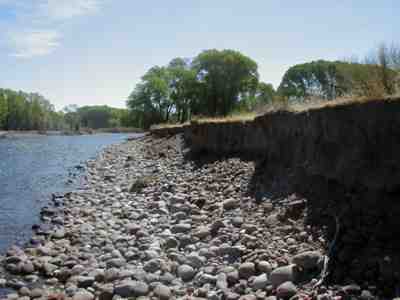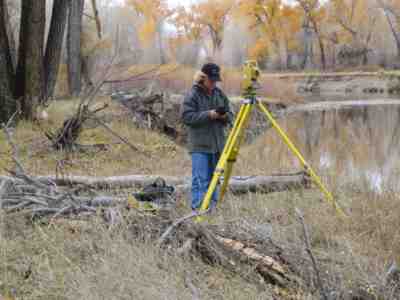Article by Marcia Darnell
Environment – May 2006 – Colorado Central Magazine
Cooperation among environmentalists, landowners, and government is rare, but when it works, it flows. Such teamwork is taking place on the historic Rio Grande in southern Colorado.
The Rio Grande Headwaters Restoration Project unites disparate groups who depend on the river in order to restore and preserve the great waters, one reach at a time. This endeavor was started by the San Luis Valley Water Conservancy District in 1999 when the district’s board applied for funds from the Colorado Water Conservation Board for a study of the Rio Grande and its functions.
Mike Gibson heads the project. “We’re focusing on the most human-impacted reach of the river,” said Gibson about the 91-mile stretch from South Fork to the Alamosa-Costilla county line.
The board put the word out in the San Luis Valley to involve “irrigators, farmers, ranchers, members from the environmental community — essentially anybody who had an interest in the river and its functions,” said Gibson.
Those community members became a technical advisory board, along with the staffs of the Colorado Division of Water Resources and the state Division of Wildlife, the U.S. Fish and Wildlife Service and Natural Resource Conservation Service. When the study was completed in 2001, the advisory group morphed into a task force.
Gibson was with The Nature Conservancy in the San Luis Valley, and became a member of the task force.

“That task force is essentially open to anybody who cares to attend the meetings,” said Gibson. “Their opinions and ideas are listened to, and it’s very democratic. No one is excluded.”
“From The Nature Conservancy’s standpoint, the river corridors in the valley represent significant ecological systems,” Gibson said. He later left TNC and joined the district.
Work completed so far has focused on restoring the banks of the Rio Grande.
“The river, from a geomorphology standpoint, up in the mountains is an eroding river, and in the valley it’s a depositional river,” said Gibson. “Significant streambank erosion has resulted in part from poor grazing practices, or the changes in function of the river, possibly caused by drought, possibly by man-made activities. These have changed the flooding pattern and the flow pattern of the river, so we have not had revegetation on the streambanks.”
Curatives have included the placement of structures, for example, putting “j hooks,” into the water, thereby re-routing the river from the eroding banks into a channel, thus saving the banks and increasing depth-to-width ratio, which improves fish habitat. Private landowners have agreed to preserve the riparian zone along the river by putting in fencing, planting willows and shrubs, and modifying their grazing practices.
There has been no dredging, rip-rap, or dumping of earth on the streambanks.
“The intent is to let nature heal the river, but we give it a start,” said Gibson. “It’s a science and an art.”
The slow flow of funds dictates the pace of the work. Since the formation of the task force, the project has sought funding. Gibson scored an EPA 319 grant for $150,000 for restoration work, and a $30,000 National Fish and Wildlife Foundation grant. The project has also received contributions from the Rio Grande Water Conservation District.
Funding has been applied for from Water 2025, a Bureau of Reclamation challenge grant program, to help get a cost estimate to replace a diversion structure. There are 47 diversions on that part of the Rio Grande.
“Those diversions, from a geomorphology — or river function — standpoint are hard points on the river, and traditionally the irrigation companies have not been really cognizant of the impact those diversion structures can have on the river both upstream and downstream,” Gibson said. “The study recommended that some of these structures be replaced, maybe some of them consolidated. Instead of having three within a quarter-mile reach, we might only have two.”

Another study is being funded by the Colorado Watershed Protection Fund, a checkoff on state income tax forms, and by severance taxes through the Colorado Water Conservation Board, and with an EPA 319 grant that is administered by the state’s Dept. Of Public Health and Environment.
“That study will embrace the true headwaters of the river and will go all the way to the New Mexico state line.” It will look at the whole watershed to determine what’s happening upstream and downstream of the studied 91 miles.
Community outreach both upstream and downstream is facilitating private contributions, both of money and cooperation. The Willow Creek Project addresses drainage problems from the mines near Creede. The U.S. Forest Service is developing management plans for lands adjacent to the river, and landowners are doing individual work on the river where it adjoins their property.
“The work that has been done on the river has been primarily driven by the opportunity we’ve had to work with landowners,” Gibson said.
Groups like Ducks Unlimited and the Rio Grande Headwaters Land Trust are also involved, and are working with landowners to place conservation easements on land along the river.
The project has also been working on design standards for development along the river in order to minimize any impacts development will have on the river corridor. Those standards may become a model for other counties. The Rio Grande County Planning Commission has asked for the project’s input on ways to manage development along the river, especially near the town of South Fork.
The project formed a non-profit foundation in 2004, the Colorado Rio Grande Restoration Foundation, so donations are tax-deductible. The reach of the Rio Grande from the Costilla County line to New Mexico is the object of legislation to designate it an “outstanding natural area,” a move that would protect the river and the state’s water rights in that reach.
With the right mix of awareness, money, work and cooperation, the Rio Grande may yet heal, and run on.
For more information on the Rio Grande Headwaters Restoration Project, contact Mike Gibson, 719-589-2230 or slvwcdco1@qwest.net.
Marcia Darnell is a freelance journalist in the San Luis Valley of Colorado.

